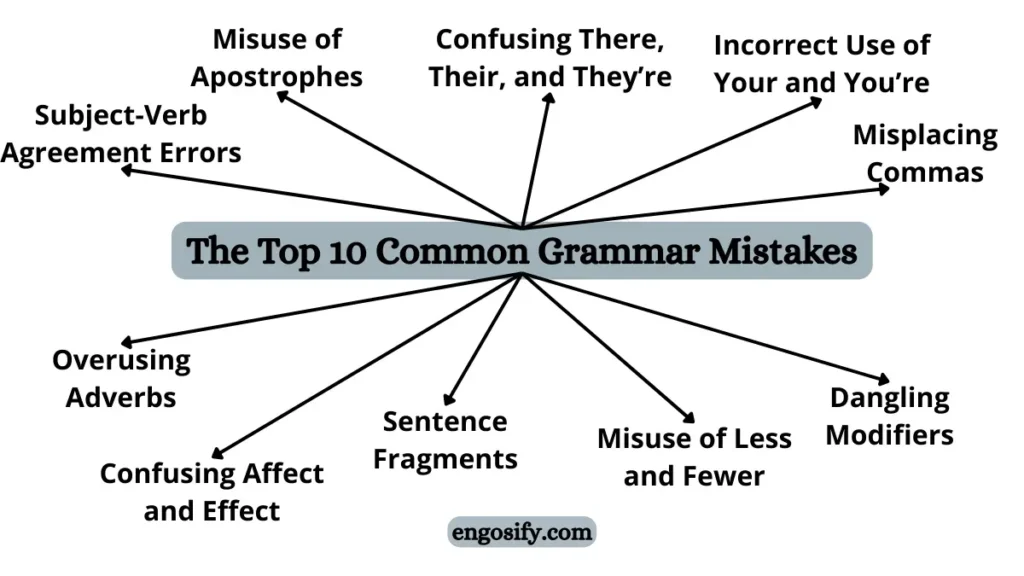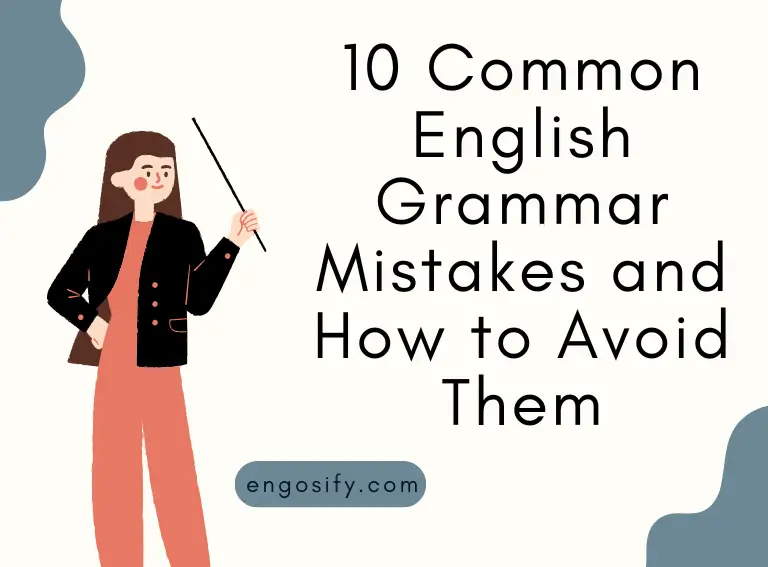Introduction
Have you ever paused mid-sentence, wondering whether you said “its” or “it’s” correctly? Or maybe you’ve felt unsure about whether to write “less” or “fewer” in a sentence. Don’t worry—you’re not alone! Even seasoned writers trip over common English grammar mistakes more often than they’d like to admit. From misplacing commas to confusing homophones like their, there, and they’re, these little blunders can slip in unnoticed, making your writing appear sloppy or unclear.
In this article, we’re going to dive into the 10 most frequent grammar errors and show you exactly how to avoid them. Along the way, we’ll sprinkle in practical tips, real-world examples, and even some tricks that professional editors use to keep sentences smooth and readable. Whether you’re drafting emails, writing essays, or just chatting online, mastering these rules can instantly boost your credibility and make your words shine.
By the end, you’ll not only recognize these mistakes on sight but also confidently correct them, leaving your readers impressed and your writing crystal clear. So, grab your pen—or keyboard—and let’s unravel the mysteries of English grammar together. Oh, and don’t forget, some handy grammar guides like the Oxford English Dictionary’s comprehensive grammar guide can be a lifesaver for quick references as you go.
The Top 10 Common Grammar Mistakes
1. Subject-Verb Agreement Errors
One of the sneakiest mistakes even native speakers make is getting subject-verb agreement wrong. Simply put, the subject and the verb in a sentence must agree in number—singular subjects need singular verbs, and plural subjects need plural verbs.
Example:
- ❌ “The team are playing well.”
- ✅ “The team is playing well.”
It’s easy to get tripped up with collective nouns like “team,” “family,” or “audience.” The trick? Focus on whether the subject acts as a single unit (singular) or individuals (plural).
Tip: Always identify the main subject first before choosing the verb. And for more in-depth examples and guidance, check out Grammarly’s insights on avoiding grammar pitfalls, which break down these errors in a super clear way.
2. Misuse of Apostrophes
Ah, the apostrophe—tiny but mighty. Misplacing it can completely change your sentence’s meaning. Apostrophes are mainly used for possessive nouns or contractions, and mixing them up is a common pitfall.
Example:
- ❌ “Its going to rain.”
- ✅ “It’s going to rain.”
Remember: “It’s” = “It is”, while “its” shows possession. Confusing them can make even a simple sentence look unpolished.
Tip: When in doubt, expand the contraction. If it still makes sense, you’ve got it right. For more tips on punctuation, the Oxford English Dictionary’s grammar guide is a great resource to bookmark.
3. Confusing There, Their, and They’re
These homophones are a classic headache. Even when spoken, context matters—but in writing, one tiny slip can confuse readers.
Example:
- ✅ “They’re going to their house over there.”
Here’s the breakdown:
- There = location
- Their = possession
- They’re = they are
Tip: Substitute “they are” whenever you see they’re to double-check correctness. And if you want a deep dive into homophones and their usage, Purdue OWL’s resources for mastering grammar provide practical exercises that help you remember them easily.
4. Incorrect Use of “Your” and “You’re”
This one’s a classic trap for many writers, and it sneaks into emails, social media posts, and essays alike. Mixing up your and you’re can make even the most polished writing look careless.
Example:
- ❌ “Your welcome.”
- ✅ “You’re welcome.”
Remember: “You’re” = “You are”, while “your” shows possession. A quick trick? Try reading the sentence out loud with “you are”. If it makes sense, you need you’re.
Tip: Keep a little sticky note handy or use grammar tools when drafting, especially for professional writing. For additional examples and exercises, Grammarly’s insights on avoiding grammar pitfalls are incredibly practical and user-friendly.
5. Misplacing Commas
Commas—they’re tiny but powerful! A misplaced comma can completely change a sentence’s meaning and even make your reader do a double-take.
Example:
- ❌ “Let’s eat grandma!”
- ✅ “Let’s eat, grandma!”
Ouch! See how one little pause saved grandma? Commas are essential for separating clauses, items in a list, or introducing a pause for clarity.
Tip: Always read your sentence out loud. If it feels like a natural pause is missing, a comma might be needed. For more guidance on comma usage, check out Purdue OWL’s grammar resources, which break it down with simple examples.

6. Overusing Adverbs
Adverbs—words that end in -ly like quickly or silently—are meant to enhance your writing, but overusing them can make your sentences weak and repetitive.
Example:
- ❌ “She ran very quickly to the store.”
- ✅ “She sprinted to the store.”
Tip: Swap long adverbial phrases for strong verbs whenever possible. This keeps your writing punchy and natural. If you want to explore more examples and practical tips, Oxford International English offers excellent explanations for learners of all levels.
7. Confusing “Affect” and “Effect”
Ah, affect vs. effect—another pair that trips up writers. Although they sound similar, their roles in a sentence are very different.
Example:
- ❌ “The weather will effect our plans.”
- ✅ “The weather will affect our plans.”
- ✅ “The effect of the storm was devastating.”
Tip: Remember this simple trick: Affect is usually a verb (an action), while effect is usually a noun (the result). For a more thorough explanation with real examples, TEFL’s blog on common grammar mistakes provides clear, easy-to-remember rules.
8. Sentence Fragments
Sometimes, in the rush to write, we forget to include a full thought, resulting in sentence fragments. These incomplete sentences confuse readers and break the flow of your writing.
Example:
- ❌ “Because I was late.”
- ✅ “I missed the bus because I was late.”
Tip: Always check if your sentence has both a subject and a predicate. If one is missing, you’ve got a fragment. Reading sentences aloud can quickly reveal where something’s missing. Resources like Purdue OWL’s Writing Lab offer exercises to help you spot and correct fragments.
9. Misuse of “Less” and “Fewer”
Many people misuse less and fewer, and it’s a subtle but important distinction.
Example:
- ❌ “Less apples on the table.”
- ✅ “Fewer apples on the table.”
- ✅ “Less water in the bottle.”
Tip: Use fewer for countable nouns (apples, books, cars) and less for uncountable nouns (water, sugar, information). Mastering this small rule can instantly elevate the clarity of your writing. For extra examples and guidance, Good Housekeeping provides practical tips in everyday language.
10. Dangling Modifiers
A dangling modifier occurs when a descriptive phrase is not clearly attached to the word it modifies. It can create confusion—or hilarious misreading!
Example:
- ❌ “Walking down the street, the sky was beautiful.”
- ✅ “Walking down the street, I noticed the sky was beautiful.”
Tip: Always place modifiers next to the word they describe. A simple rearrangement can save your sentence from misinterpretation. For more examples and exercises, check out Pomona College’s guide to common grammar mistakes.
FAQs
What is the most common grammar mistake?
One of the most frequent slip-ups is subject-verb agreement errors. It’s easy to overlook, especially with collective nouns like team, family, or audience. Checking whether the subject is singular or plural before picking the verb can save a lot of headaches.
How can I improve my grammar skills?
Consistent practice is key! Read widely, write regularly, and use grammar-check tools. Resources like Grammarly’s insights on avoiding grammar pitfalls offer step-by-step tips and exercises to catch and correct common mistakes.
Is it okay to end a sentence with a preposition?
Modern English usage generally accepts ending sentences with prepositions, especially in casual writing. However, in formal or academic contexts, it’s often better to restructure the sentence to avoid awkward phrasing.
When should I use “who” vs. “whom”?
- Who = subject of a clause (performs the action)
- Whom = object of a clause (receives the action)
Example:
- ✅ “Who is coming to the meeting?”
- ✅ “To whom should I address this letter?”
A simple trick: replace who with he/she and whom with him/her to see which sounds correct.
What is a dangling modifier?
A dangling modifier is a descriptive phrase that doesn’t clearly attach to the word it’s meant to modify, which can confuse readers.
Example:
- ❌ “After reading the book, the movie was disappointing.”
- ✅ “After reading the book, I found the movie disappointing.”
Being mindful of sentence structure and placing modifiers next to the words they describe helps eliminate dangling modifiers.
How can I remember tricky homophones like “there,” “their,” and “they’re”?
Practice and context are your best friends. Substituting they are whenever you see they’re can confirm correctness. Reading sentences aloud also helps you spot mistakes naturally.
Conclusion
Mastering common English grammar mistakes may feel daunting at first, but with practice, patience, and attention to detail, it becomes second nature. From subject-verb agreement to tricky homophones like there, their, and they’re, each rule you learn adds clarity and professionalism to your writing.
Remember, small adjustments—like placing commas correctly, using the right modifiers, or choosing fewer instead of less—can make a huge difference. Keep handy resources like the Oxford English Dictionary’s comprehensive grammar guide close by, and don’t hesitate to use grammar tools for quick checks.
By applying these tips consistently, you’ll write more confidently, avoid common pitfalls, and make your words shine—whether in emails, essays, or social media posts. Practice regularly, stay curious, and soon, grammar mistakes will become a thing of the past!

